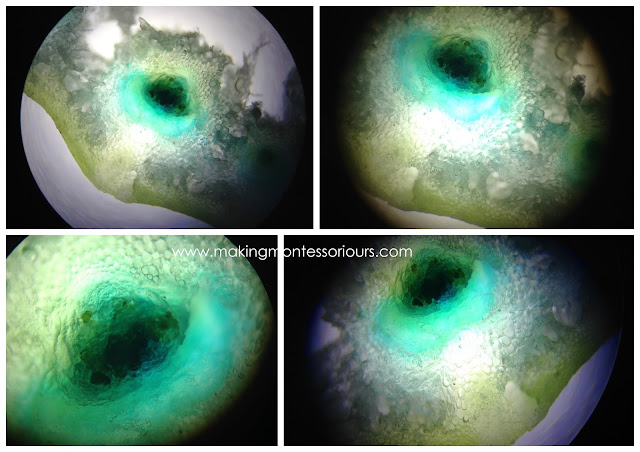I've mentioned often that we love to garden as a family, so we've had great fun planting and exploring our gardens in all stages of growth. Our gardens are one of our most treasured fair weather gifts where we live. The flowers you see below are from our hosta plants. This is a particularly fragrant variety, that smells much like lilac blooms 💜
Our purpose was to explore how a plant drinks water. Some form of dye or colouring, helps your child to see this process very clearly. There are countless posts and variations online, so choose the one that looks fun to you.
Our children were inspired to do this exploration quite spur of the moment, so we used the plant material that we had right at home!
We used two kinds of food colouring (liquid and gel concentrated colours), and both worked very well. Using some form of clear glass looks cool in photos, but really the purpose is to keep a clear view of the plant for observation.
Our flowers stayed in the glasses for several days, and around day two was when we really noticed the colour making it's way through the stem to the blooms.You could certainly try this with different flowers, and track the results. This is a fun time to take a closer look with magnification in what ever form you have. Microscopes in some form are wonderful, but so are cheap magnifying glasses!

We pulled out our microscope and camera to take a closer look. We do have a lens camera, that connects simply to my laptop for viewing. Focusing our camera takes a good deal of practice, but produces some fun results. The most clear examples that we viewed were directly through the scope lens.
We created our own slides of stem cross sections. We used a really sharp blade to get very thin slices of the uncoloured and coloured stems, to check out and compare. The best cross section slides we've used have been those we have purchased, but these turned out extremely well!
Below you can see the uncoloured cross section example. You can clearly see the structures and vascular bundles in the stem. The blue dyed example was so pretty, and amazing to view. The shots with a black circular perimeter were taken with my iPhone, and they were amazing!
Next we took a look at celery! This was done basically the same as above with our flower stems. Xander decided again to keep a control of clear water, they chose blue and red again for their coloured solutions.
We waited several days again monitoring the progress. The celery certainly was far more noticable in terms of progress and colour change. I've seen many use romaine lettuce and carnations (most common), and they have great results.
The most striking thing about the lettuce were the leaves and cross sections under the scope! They were like stunning works of art, with such vibrant colour! Both of these images were taken with our iPhone. The leaves look quite different, but that is mainly due to the magnification.
The vascular bundles were stunning, and so easy to see in celery.
Isn't that incredible!!💕
We have created cross-section 3 Part Cards, Definitions and Pin maps for those who are looking for these materials. You can find them in our shop.
Happy explorations!!






















0 comments:
Post a Comment
I greatly appreciate your friendly comments and feedback. I love to see what others are making, so please feel free to include a links and share your site with us!!! If you have any questions regarding any of the materials we have made...I'd love to help!!! Thank you for visiting us:)